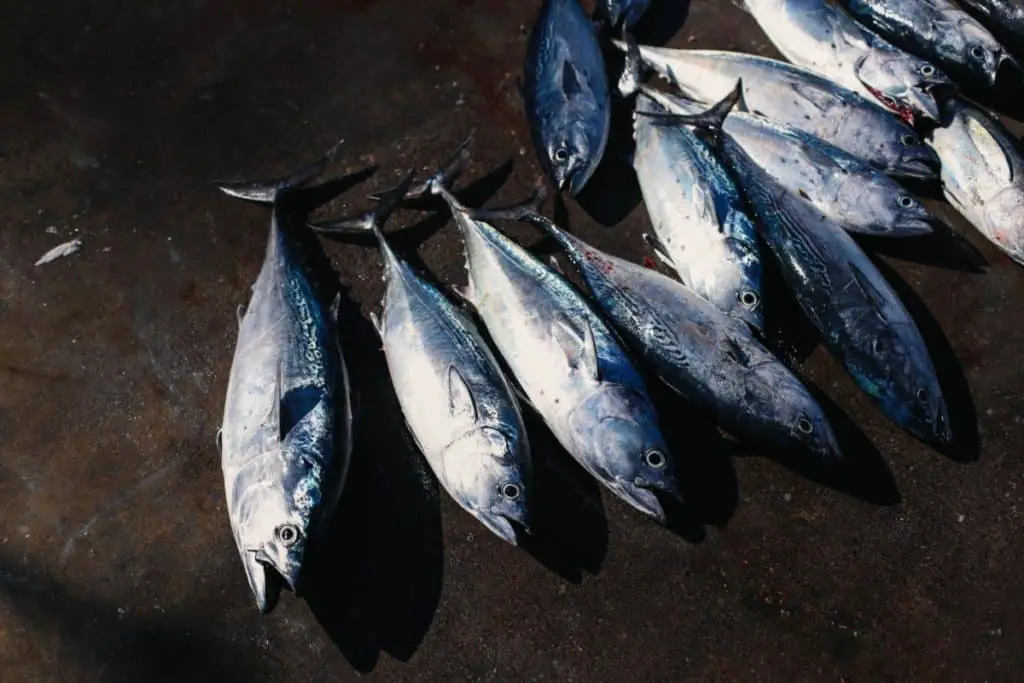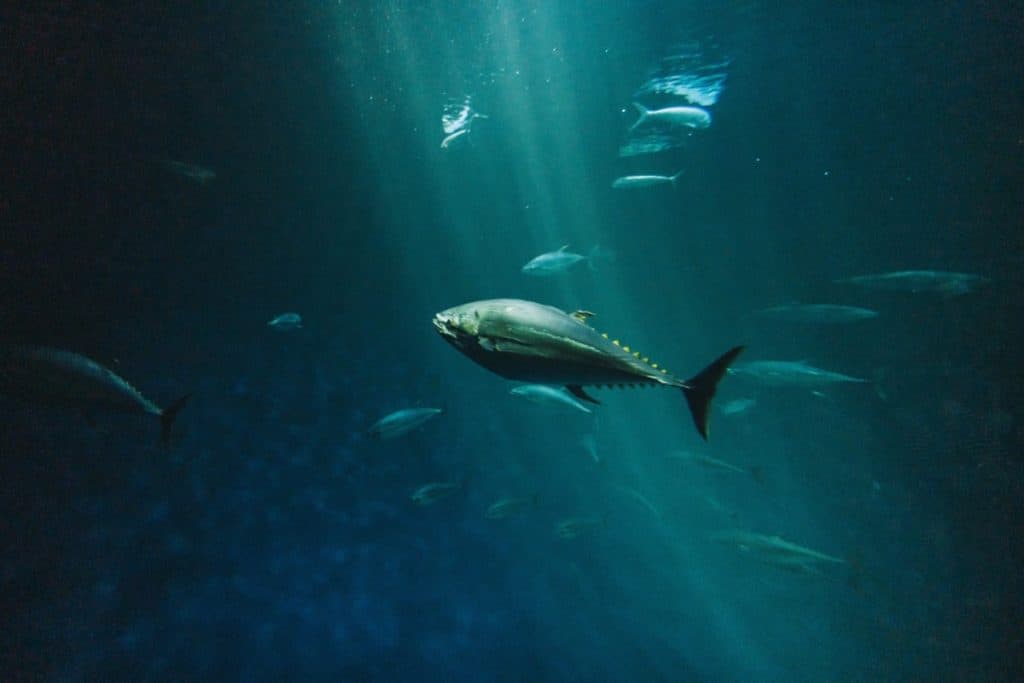
If you are interested in finding out whether a tuna is a producer, a consumer, or a decomposer then you’ve come to the right article.
As, in this article, you’ll find the exact answer to this question, and also after you’ve read the answer to the main question then I’ll cover the answers to a few more closely related questions as well to extend your knowledge further.
I hope you learn a lot from this article.
Is a Tuna A Producer, A Consumer, Or A Decomposer?
The tuna fish is categorized as a consumer in marine ecosystems.
It is neither a producer nor a decomposer because it primarily consumes smaller animals.
Tuna have a varied diet and routinely eat crayfish, shrimp, krill, cuttlefish, barnacles, crabs, and even octopuses.
On rare occasions, they will eat kelp and other types of plant matter but their diet is overwhelmingly carnivorous.
Bluefin tuna, the largest tuna species on the planet, is a consumer and highly successful predator.
It can grow up to four meters long and weigh as much as 2,000 lbs which is heavier than some horses.
The bluefin’s size and its torpedo-shaped body make it an apex predator in sharkless waters because few other animals (except for killer whales) can hunt them.
Despite the species’ size, it can swim as fast as 43 miles per hour and travels vast distances for migration and hunting.
Bluefin Tuna consume a broad variety of prey but have a preference for pelagic fish and invertebrates that they can swallow whole.
Juvenile and mature bluefins are opportunistic hunters that will eat jellyfish and salps as readily as demersal and sessile species like octopi and soft-bodied sponges.
Check out the video below if you want to learn more about these forgotten superpredators named tuna.
Is Tuna A Primary Consumer?
Tuna is a secondary and tertiary consumer (not a primary consumer) because they are not herbivores.
Like other tertiary consumers, tuna need organic carbon from plants to survive and get it by eating primary and secondary consumers rather than eating the plants themselves.
Tuna eat primary consumers (herbivores) such as shrimp, barnacles, krill, and larger secondary consumers (omnivores) like squid, octopi, cuttlefish, lobsters, crabs, smaller fish species, and even eels.
They’re considered secondary and tertiary consumers because they almost exclusively consume other animals.
Is Tuna A Secondary Consumer?
Tuna can be both a secondary and tertiary consumer depending on the environment and circumstances.
Tuna is not a primary consumer because it rarely consumes plant matter and could not survive without eating other animals.
Tuna fish are secondary consumers because their diet consists primarily of herbivorous plant-eating organisms.
Though some larger species are known to hunt carnivorous fish such as octopi, squid, lobsters, and even eels making them tertiary consumers as well.
Tuna are opportunistic hunters that are only limited by their size.
Bigger species (bluefin and yellowfin) regularly stalk and kill other meat-eating fish.
Is Yellowfin Tuna A Secondary Consumer?
Yellowfin Tuna are considered both secondary and tertiary consumers because they have a carnivorous diet.
They don’t only consume smaller plant-eating animals.
Yellowfins are powerful enough to hunt and kill other omnivorous fish such as mackerel, pilchards, herring, and anchovies as well as shrimp, squid, and crabs.
Tertiary consumers differ from secondary consumers because the former mostly or only eat plant-eating herbivorous species.
Yellowfin tuna also eat other predatory fish so they are sometimes secondary consumers and sometimes tertiary consumers.
Check out the video below if you want to see Bluefin tunas hunt mackerels.
Is Tuna A Tertiary Consumer?
Most tuna species can be categorized as secondary and tertiary consumers.
Tuna are not primary consumers because they rarely access plant nutrients directly from plants.
Depending on the species, tuna feed on plant-eating herbivores (primary consumers) or hunt other carnivorous fish (secondary consumers).
This is why they can be included in both classifications.
The tuna’s massive size, razor-sharp teeth, and powerful jaw enable it to feed on other formidably-sized fish including mackerel, bluefish, surgeonfish, sardines, surfperches, bluefish, and even eels on occasion.
Few other animals pose a threat to them with only sharks and whales acting as consistent food chain predators.

Is A Tuna A Quaternary Consumer?
Tuna are not quaternary consumers.
They are tertiary and secondary consumers at different times and in different environments.
Large species such as the Bluefin and Yellowfin come close to topping the food chain but it is rare for even these to be without natural predators.
Apex predators such as whales, sharks, and billfishes are known to hunt and eat tuna which makes them the quaternary consumers in the food chain.
Nonetheless, tuna are extremely capable hunters with the sharpest vision of any bony fish species and they also have streamlined bodies designed for speed and endurance.
Is A Tuna A Herbivore?
Tuna fish are not herbivores.
Their diet is almost entirely carnivorous and they start hunting almost immediately after birth.
However, these fish are also opportunistic and have been observed eating plankton, kelp, seaweed, and other vegetable matter on occasion.
But tuna fish are still considered obligate carnivores.
They cannot get sufficient nutrients from a herbivorous diet.
They survive by eating shellfish, squid, eels, minnows, smaller fish, crabs, lobsters, cuttlefish, barnacles, shrimp, crayfish, and many more animals.
Is A Tuna A Carnivore?
Tuna fish are highly carnivorous marine creatures with a meat-rich diet made up of everything from lobster to crayfish, eel, cuttlefish, crabs, barnacles, shrimp, and squid.
Some very large species like Bluefin Tuna are excellent hunters and have few natural predators.
In most regions, only the most ferocious marine mammals, and fish (like sharks and whales) can threaten their dominance which makes the Bluefin Tuna an apex predator in waters where sharks and whales are scarce.
Tuna fish are known to eat plants on occasion (mostly seaweed and kelp) but it is usually an opportunistic behavior or one that’s motivated by food scarcity.
They cannot survive on a herbivorous diet.
Is A Tuna An Omnivore?
Tuna fish are not omnivorous.
They are a carnivorous marine species with a diet that’s largely made up of shellfish, squid, eels, octopi, smaller fish, crabs, lobsters, barnacles, shrimp, and crayfish.
Though tuna fish are known to consume plants (like algae, seaweed, and kelp) on occasion, this habit is indicative of their opportunistic nature and doesn’t accurately reflect the animal’s diet.
Tuna fish are secondary and tertiary consumers because they almost exclusively eat other animals (primary and secondary consumers).
A truly omnivorous diet could not sustain these obligate carnivores and their formidable weight and size.
A typical adult Bluefin can weigh anywhere between 350 and 550 lbs and can be as much as 8 feet in length when measured from tip to tail.
